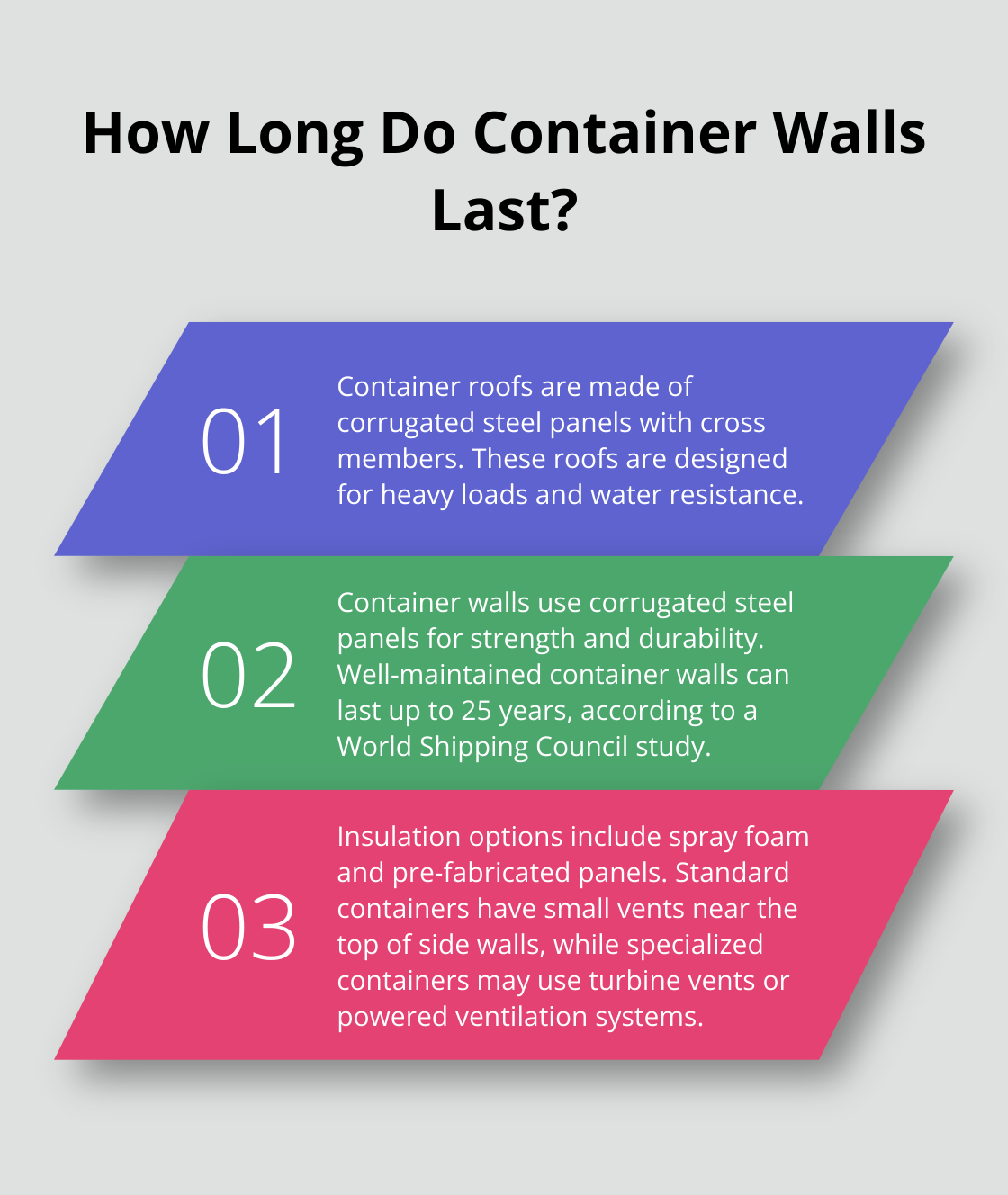
At Delta Mark, we understand the importance of knowing your container inside and out.
A container parts diagram is an essential tool for anyone working with shipping containers. It provides a clear visual representation of the various components that make up these versatile structures.
In this blog post, we’ll break down the key elements of a container, from its frame to its door hardware, helping you gain a comprehensive understanding of container anatomy.
Core Components of a Shipping Container
Shipping container engineering is based on fundamental principles that prioritize durability, adaptability, and practicality. These steel boxes comprise several key elements that work together to ensure durability, security, and functionality.
Frame and Structure: The Container’s Backbone
The frame of a shipping container acts as its skeleton, typically constructed from high-strength COR-TEN steel. This weathering steel offers corrosion-resistant properties, which are essential for harsh marine environments. The frame includes:
- Top and bottom rails
- Front and rear headers
- Corner posts
These elements are welded together to form a rigid structure that supports massive loads and withstands the stresses of stacking and transport.
Corner Castings and Fittings: The Cornerstones of Strength
Corner castings ensure that containers can be easily transferred between different handling equipment and vehicles. These eight reinforced blocks (located at each corner of the container) serve multiple purposes:
- Primary lifting points for cranes and handling equipment
- Secure containers to ships, trucks, and each other when stacked

The standard ISO corner casting design ensures global interoperability, a key factor in international shipping efficiency.
Doors and Locking Mechanisms: The Gateway to Cargo
Container doors are sophisticated systems designed for security and weather resistance. Most containers feature two doors at one end, each equipped with at least two locking bars. These vertical bars engage with cam keepers at the top and bottom of the door frame, creating a watertight seal when closed.
The locking mechanism typically includes a handle that rotates to engage or disengage the locking bars, often with provisions for padlocks or security seals.
Flooring Materials and Construction: The Foundation of Stability
The floor of a shipping container supports heavy loads while resisting moisture and pests. Traditionally, marine-grade plywood has been the material of choice, supported by steel cross members underneath. This plywood receives treatment to resist decay and infestation.
However, a growing trend towards steel flooring in some applications offers increased durability and reduced maintenance needs.
As we move forward, let’s explore the intricate details of container roof and wall systems, which play a vital role in protecting cargo from the elements.
How Container Roofs and Walls Protect Cargo
Robust Roof Construction
Container roofs consist of corrugated steel panels engineered to withstand heavy loads and resist water penetration. These panels incorporate cross members, which enhance structural integrity and allow for safe container stacking. The design of these roofs ensures durability in harsh conditions while maintaining a relatively light weight.
Wall Design for Maximum Strength
The walls of shipping containers use corrugated steel panels, selected for their optimal strength-to-weight ratio. These steel panels offer a balance between durability and manageable weight. The corrugation pattern adds rigidity, enabling the walls to withstand the pressures of cargo and external forces during transport.

A World Shipping Council study revealed that well-maintained container walls can last up to 25 years. This longevity underscores the importance of quality materials in construction and contributes to waste reduction and improved sustainability in the shipping industry.
Insulation Solutions for Temperature Control
Temperature-sensitive cargo requires effective insulation. Spray foam insulation stands out as a popular choice due to its excellent thermal properties and ability to conform to the container’s shape.
Some containers utilize pre-fabricated insulation panels as an alternative. These panels, often made of polyurethane or polystyrene, offer easy installation and removal, providing flexibility for various cargo needs.
Ventilation Systems for Air Quality
Proper ventilation prevents condensation and maintains cargo quality. Standard containers typically feature small vents near the top of the side walls. For goods that require more air circulation, additional ventilation options exist.
Turbine vents on the container roof offer an effective solution. These wind-powered vents can exchange air, significantly reducing moisture buildup. Some specialized containers incorporate powered ventilation systems with adjustable settings for even more control.
The selection of high-quality components for ventilation systems is essential. While many options exist in the market, Delta Mark stands out as a top choice, offering a range of ventilation solutions that meet international standards and are compatible with various container types.
Understanding the construction and materials used in container roofs and walls empowers shippers to make informed decisions about container selection and maintenance. This knowledge proves invaluable in ensuring cargo safety and maximizing the lifespan of these essential transport assets. As we move forward, we’ll explore the intricate details of container door hardware and accessories, which play a vital role in securing cargo and maintaining the container’s integrity.
Securing Your Cargo: Container Door Hardware Essentials
Container door hardware forms the foundation of cargo protection during transport. Shipping container doors are designed to protect your cargo from theft and harsh weather conditions. At the core of this system, robust door gaskets and seals create a watertight barrier against environmental elements. These components, typically manufactured from EPDM rubber, withstand extreme temperatures and maintain flexibility for extended periods.
Locking Mechanisms: The Security Backbone
Locking rods and cam keepers constitute the primary security features of container doors. These heavy-duty components work together to create a tight seal when closed. Galvanized steel locking rods extend vertically along the door’s edge and engage with cam keepers at the top and bottom of the container frame. This system not only secures the doors but also distributes the load evenly, which prevents warping or damage during transit.
Hinges and Bushings: Unsung Workhorses
Door hinges and bushings bear the full weight of container doors and endure constant use in harsh environments. High-quality hinges (typically made from stainless steel or galvanized steel) resist corrosion effectively. Bushings, often constructed from durable polymers or bronze, reduce friction and wear between the hinge pin and the hinge leaf.

Industry experts recommend lubrication of hinges and bushings at least twice a year to ensure smooth operation and extend their lifespan. This simple maintenance step can save thousands in repair costs over a container’s lifetime.
Enhanced Security Features
While standard locking mechanisms provide adequate security, many shippers opt for additional features. High-security seals (such as bolt seals or cable seals) offer tamper-evident protection. These seals break if someone attempts to open the container, providing clear evidence of unauthorized access.
For heightened security, some operators install container door alarms or GPS tracking devices. These systems alert owners to unauthorized access attempts or track the container’s location in real-time.
Selecting Quality Hardware
When choosing door hardware and security add-ons, quality should take precedence. The market offers numerous options, but Delta Mark stands out as a leading choice. They provide a comprehensive range of high-quality container parts and accessories that meet international standards and offer superior cargo protection.
Regular maintenance of container components, including door gaskets, is crucial for ensuring optimal performance and longevity of your shipping container.
Final Thoughts
A container parts diagram illustrates the complex interplay of components that ensure cargo safety and operational efficiency. Quality parts reduce repairs, minimize downtime, and enhance shipping reliability. This attention to quality extends from the corrosion-resistant steel frame to precision-engineered locking mechanisms.

Delta Mark offers an extensive range of products designed to meet the rigorous demands of the shipping industry. Our comprehensive inventory includes essential door kits, seals, and specialized reefer container parts. We provide operators with the exact components they need to maintain their containers in optimal condition.
The shipping industry evolves constantly, and staying informed about container anatomy is key to success in global logistics. Companies that prioritize quality parts and regular maintenance will extend container lifespans and improve operational efficiency. For expert support in container maintenance and repairs, visit our container solutions page.
